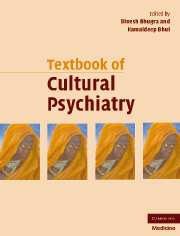Book contents
- Frontmatter
- Contents
- Contributors
- Foreword
- Preface
- Part I Theoretical background
- Part II Culture and mental health
- Part III Culture and mental disorders
- Part IV Theoretical aspects of management
- 26 Traumascape: an ecological–cultural–historical model for extreme stress
- 27 Sexual dysfunction across cultures
- 28 Therapist–patient interactions and expectations
- 29 Developing mental-health services for multicultural societies
- 30 Psychopharmacology across cultures
- 31 Psychotherapy across cultures
- 32 Psychological interventions and assessments
- 33 Spiritual aspects of management
- 34 Cultural aspects of suicide
- Part V Management with special groups
- Part VI Cultural research and training
- Cultural psychiatry: the past and the future
- Index
- References
30 - Psychopharmacology across cultures
from Part IV - Theoretical aspects of management
Published online by Cambridge University Press: 11 August 2009
- Frontmatter
- Contents
- Contributors
- Foreword
- Preface
- Part I Theoretical background
- Part II Culture and mental health
- Part III Culture and mental disorders
- Part IV Theoretical aspects of management
- 26 Traumascape: an ecological–cultural–historical model for extreme stress
- 27 Sexual dysfunction across cultures
- 28 Therapist–patient interactions and expectations
- 29 Developing mental-health services for multicultural societies
- 30 Psychopharmacology across cultures
- 31 Psychotherapy across cultures
- 32 Psychological interventions and assessments
- 33 Spiritual aspects of management
- 34 Cultural aspects of suicide
- Part V Management with special groups
- Part VI Cultural research and training
- Cultural psychiatry: the past and the future
- Index
- References
Summary
EDITORS' INTRODUCTION
The debate on the use of medication in managing psychiatric disorders focuses on a number of themes. These include availability of drugs, affordability and accessibility of medication, prescribing patterns such as the use of polypharmacy, application of doses across different ethnic groups as well as differences in drug metabolism, pharmacokinetics and pharmacodynamics. With a shift to more drug trials taking place in the Indian subcontinent and Eastern Europe, the question of ethics is beginning to be raised. In cultures where there is a shortage of trained mental-health professionals and drugs are available over the counter, the management of patients with psychiatric disorders becomes even more complex.
In this chapter on psychopharmacology across cultures, Yu and colleagues provide an overview of some of these issues. They observe that the one size fits all approach is problematic to say the least. Both genetic and environmental mechanisms are important in order to determine ethnic/cultural variations in drug responses. These variations are mediated via the pharmacokinetics and/or pharmacodynamics processes, whereas the pharmacokinetic process determines how the organism responds to the therapeutic agent. Absorption, distribution, metabolism and excretion of the drugs determine the fate and disposition of most drugs, and these factors also highlight the differences in group and individual responses. Pharmacogenetics of various enzymes further contribute to variation in response. Pharmacodynamic mechanisms also exert major influences on therapeutic target's response to psychotropics. The sociocultural context of pharmacotherapy for psychiatric disorders is equally important. The role of diet, attitudes to religions and dietary taboos, religious fasting, smoking and intake of caffeine are also important in understanding response to medication.
- Type
- Chapter
- Information
- Textbook of Cultural Psychiatry , pp. 402 - 413Publisher: Cambridge University PressPrint publication year: 2007
References
- 4
- Cited by



